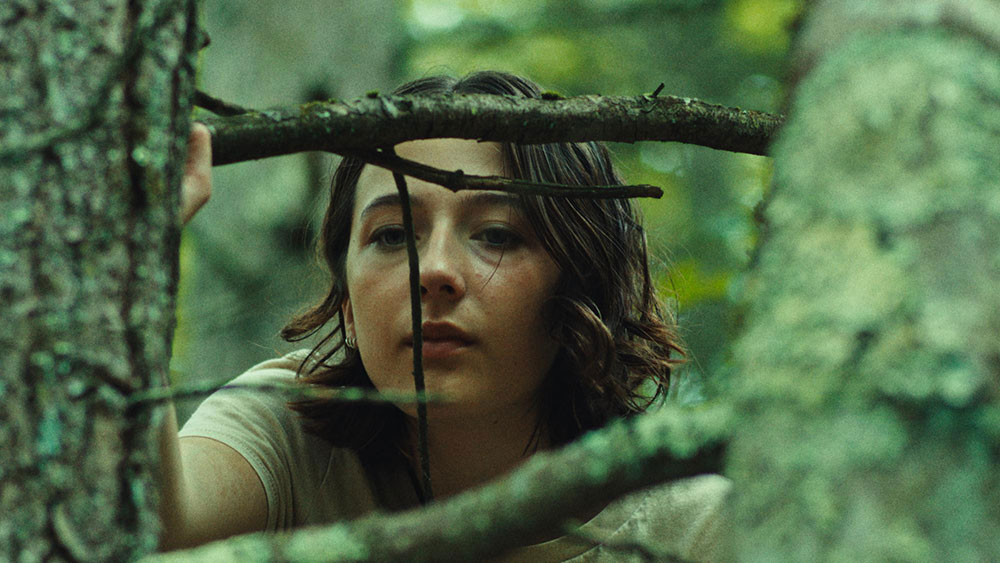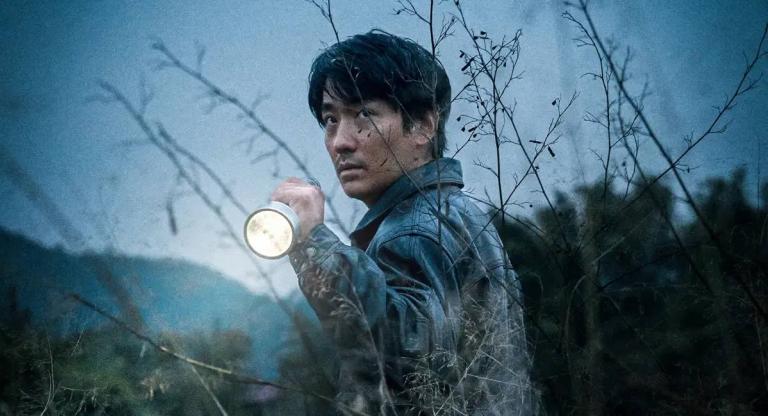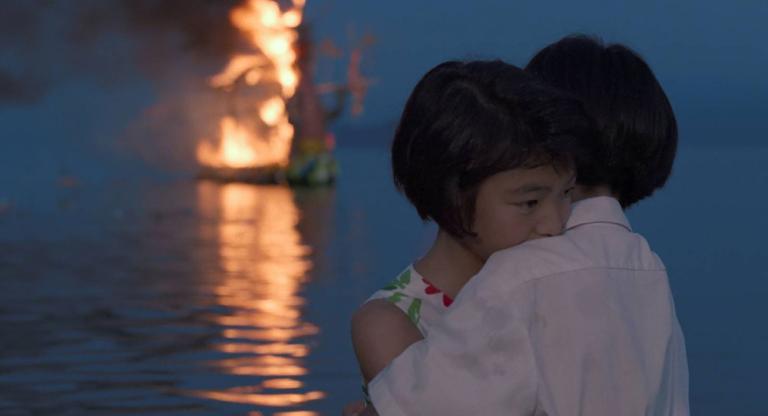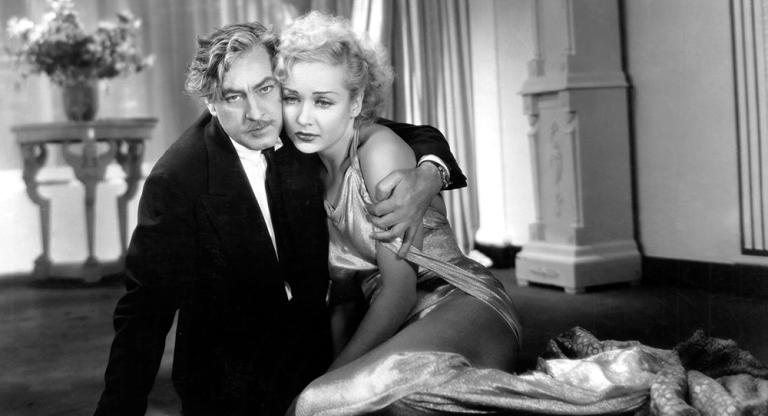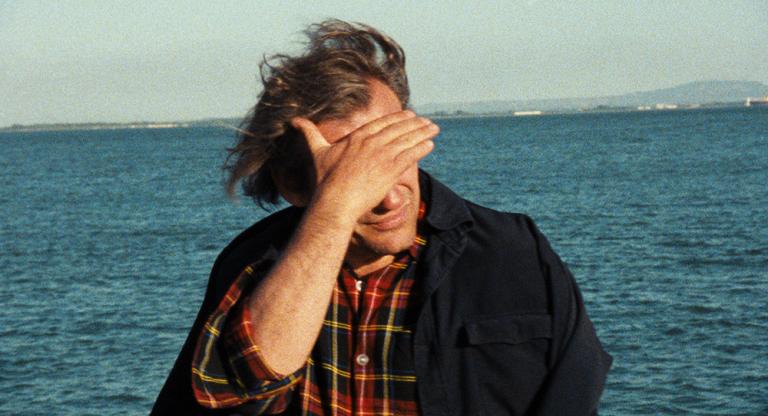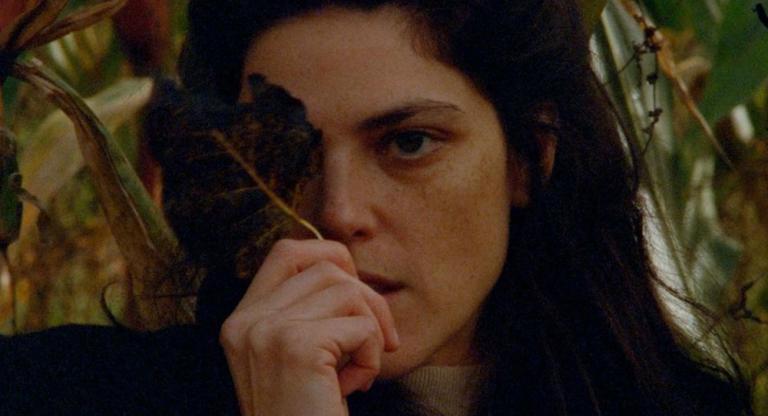India Donaldson’s Good One (2024) is a confident and finely-tuned first feature that turns a weekend in the woods into a coming-of-age gut punch. After premiering earlier this year at the Sundance FIlm Festival, the film had a small but impressive festival run, screening at both New Directors/New Films and Directors’ Fortnight at the Cannes Film Festival. Now, a larger audience will get the chance to see this striking debut, which also features a career-launching lead performance.
The talented newcomer Lily Collias plays Sam, a queer 17-year-old who embarks on a backpacking trip in the Catskills with her father Chris (James Le Gros) and his jocular best friend Matt (Danny McCarthy). Sam is smart and self-sufficient, capable of setting up camp and cooking in the forest, and often looking out for the two grown men whose decades-long friendship appears strained for unknown reasons. She observes their dynamic throughout the trip, and also acts as a buffer between the two, laughing at their stale jokes and occasionally offering wisdom that seems well beyond her years. Le Gros and McCarthy, both accomplished character actors, shine in their embodiment of men who are carrying the baggage of their adult lives with them on the trip, ruminating on bruised egos, broken marriages, and dreams unfulfilled. Things eventually take a sharp turn, for the trip itself and Sam’s personal journey, as she’s faced with uncomfortable truths about her fellow travelers.
I had the pleasure of speaking with Donaldson about her experience shooting the film, her collaboration with the actors, and how she crafted such a subtle but emotionally wrenching drama. Our conversation has been edited for length and clarity.

Stephanie Monohan: What was your starting point with Good One? Did you have the idea of a trio on a camping trip and then build the story and characters around that? Or, did you begin with themes that you wanted the film to communicate and go from there?
India Donaldson: The true starting point for me was trying to conceptualize how I could make a film in an intimate way that is manageable from a production standpoint, but is still ambitious in the emotional scope of the story. That was the foundational question. I wrote it during Covid, when it became so much harder to make an independent film, and the idea of shooting primarily outdoors seemed doable, so that drove the setting in many ways.
I was also living at home with my family for the first time since I was in high school. I have two half-siblings who were in high school at the time (2020) and I was observing my younger sister in particular, how she was navigating this moment of still being a kid but with the end in sight, seeing the future for herself outside the walls of her childhood home. I was watching her while also reflecting very deeply on that time in my own life. So it was a convergence of all of these circumstances.
SM: Covid-logistics aside, you shot the film almost entirely outdoors in just twelve days, which already sounds challenging. Were there any happy surprises that shooting on such a tight schedule, and at such a location, granted you?
ID: I learned, in the process of shooting outdoors, that you have to just react to what you’re finding, and we didn’t have the luxury of pushing scenes if we had a cloudy or rainy day. Also, the actors’ strike was looming and was potentially going to start the day after we wrapped, so we really didn’t have any margin for error. But having to just make it work was a gift. We had to build the weather into the story, which creates all this texture that you can’t plan for, like the wetness of the scene where they’re playing cards with the three hiker boys that join them. Or in the scene where Sam confronts her dad by the waterfall, we had these clouds coming in and out with bright sun shining through unpredictably, which added this harshness to the moment. It allowed the quality of shooting the film to bleed into the story and that you can’t really plan for.
Then there were all of the bugs and the butterflies, all of these little creatures that just showed up for us that we captured. I wasn’t really planning on all of that nature imagery to be such a big part of the edit, but because we captured these little snapshots of the natural world around them [the characters] that they were not noticing or reacting to, it brought this element to the film of the forest and all the creatures that live in it were here before and will be here afterwards. These three humans are just passing through, which to me, became a significant part of the story. So the exact time and place of the shoot fundamentally changed the film. If we’d shot two weeks later, it would have been a different movie.
SM: The sounds of nature are so intensely present that they essentially create another soundtrack in the film. They also really compliment the character of Sam and where she is emotionally at any given point—she’s very at home in nature, but when she’s in a vulnerable state the sounds also emphasize how alone she is. Was the presence of sound something you had in mind initially, or did that come to life while you were shooting?
ID: That part was more by design because in my experience of camping, or being on a hike in a remote place, the natural world becomes so loud. You think of a walk in the woods as being quiet, but the heightened awareness you have of the wind passing through trees, or bugs, makes those sounds suddenly come to the surface of your awareness. I wanted to capture that in the film and in the mix, and also have that compete, texturally, with the incessant running dialogue between these two guys who are not stopping to live in that soundscape. They’re in their heads and they're uncomfortable with the silence.
The waterfall scene is kind of the prime example. I wanted the sound of their environment to compete with their conversation and for her to fight to be heard and understood. In the script I wrote for that scene to occur next to a waterfall with that rushing white noise. We knew we had to find it location scouting, because that was important to me. Maxwell di Paolo, who recorded all the production sounds, just captured so much beautiful nature. So much of what our sound designer Eli Cohn used is what we captured in the moment. We didn’t do any ADR. We really just embraced the rough-around-the-edges, real dialogue captured in these kinds of unpredictable conditions.
SM: Regarding the dialogue, it feels like there’s a perfect amount of it. The men are chatting throughout and the viewer learns just enough about them, and their dynamic, without a ton of exposition. How did you decide what was essential for the audience to know about the characters versus where they could fill in the blanks?
ID: My intention was for the characters to reveal enough so that you understand them, but not so much that the audience gets the sense that they’re being told how to feel about them. I think a lot of the paring down of the dialogue happened in collaboration with the actors when we were shooting. Once James and Danny really started, I very quickly could hear what was extraneous and could strip away to the core essence of what you need to know. With these characters, I had a clear idea of who they were and what their dynamic was, where it had come from and where it was going. And I wrote them really intuitively.
SM: Did the actors, particularly James and Danny, have a full idea of their characters’ backgrounds and how their relationship changed over the years before the film starts? They feel so fully formed that you can kind of get a sense of what they may have been like as younger men. Did you provide them with backstory?
ID: No, I really wanted to give them the opportunity to use the script as a series of clues and to fill in the blanks themselves, which I think they absolutely did in their performances. A big part of that, for me, was to allow their dynamic to evolve organically in collaboration with Lily. Especially since there’s so much triangulation through her; in my mind, everything gets filtered through that character. I learned a lot about each of the characters once the actors were in their shoes.
SM: Lily is amazing in the film. What was it like working with her since she was also in the same life-stage as the character she’s playing? Did she bring a lot of her personal experience into the role and how did that intersect with what you envisioned for the character?
ID: She really was precisely at that age. I met her when she was a junior in high school and we shot the film a week after she graduated. She was really, truly living it. Her personality is very different from the character, but she embodied so much of who the character was just from being at this transitional moment. There was another layer, too, of becoming an adult while she was becoming an actor and committing to her creative life. It was fascinating for me to watch Lily, at age 18, having an adult, professional experience and being an authority in this character. She was collaborating with people ten, twenty years older than her, but brought such a deep kind of confidence to the process that is remarkable for someone that young.
SM: The campfire scene is a key turning point in the film. Without spoiling exactly what happens, what it was like both scripting the scene and editing it, because what Matt says to Sam is so delicately deployed it feels both like a gut punch and an inevitability.
ID: I definitely want people to go into the movie knowing as little as possible, but it’s fair to say it is “a moment.” It’s one line of dialogue that the movie turns on. I was thinking about a lot of things when I wrote that scene and it was important to me that it came late in the movie for exactly the reason you just said: I wanted it to feel like a gut punch but also inevitable. I don’t think you can get both of those things without allowing the audience to sit with these characters and get to understand their points of view.
I also knew that I wanted it to come at the end of a very long scene that, in itself, had almost three acts. I wanted Matt’s character to really have the floor because he’s been beaten up in many ways emotionally before the film starts, so I really wanted him to have the opportunity to open himself up to the audience and to Sam. In my memories of sitting around a fire and telling stories, the darkness becomes a protective space where it feels safe to reveal yourself.
Graham Mason, who produced and edited the film, assembled that scene, and I think his first assembly is actually very close to how it ended up in the film. My memory of working on that scene with him is us spending so much time talking and debating one or two frames in that moment where Matt speaks and Sam reacts and then eventually says something back to him. The work was in the absolute fine tuning of when to cut away from him to her and back to him. I love living in the details and that moment required the most detailed work.
SM: I also wanted to ask about the ending, because it has such an emotionally rich tone. There’s a little act of rebellion that’s quite satisfying, and it ends on a kind of humorous note, but at the same time there’s still a sense that the relationship between Sam and her father has changed. How did you decide how you wanted this film to end?
ID: I wanted to convey this idea that relationships change both suddenly and incrementally. This moment, this event, this trip changed her dynamic with her dad fundamentally pretty much overnight, but the reality of families is that we’re steeped in each other’s needs constantly. It takes years, or even a lifetime, to evolve a relationship with your parents. This is one part of the whole—it’s one thing that will shift the rhythm of the way they communicate slightly, and maybe in ten years they’ll talk about this weekend again and form a new kind of understanding of it.
I love endings that feel like the beginning of something. Rather than feeling that we’ve fully played this story out and we don’t need to see anything more, I like the suggestion of a future beyond this world even though I’ll never see it.
Good One opens Friday, August 16, at the Smith Rafael, with director India Donaldson in person for the matinee on Saturday, August 17.
Previously:
Good One screens this evening, August 9, and throughout this weekend, at Metrograph. Director India Donaldson and actor Lily Collias will be in attendance for a Q&A. Donaldson will also appear in person following select screenings of “India Donaldson Selects.”
